HIKING HAPPENINGS December 2012
Mill Canyon Dinosaur Trail – A Big Step Back In Time
by Marcy Hafner |
If I could climb into a time machine and zoom back 150 million years, I would be shocked to discover that the canyonland country where I live doesn’t exist anymore! Instead I am hopelessly lost in a tropical rain forest of conifers, cycads and ginkgoes, which shade an undergrowth consisting largely of ferns. Nothing looks familiar, and as I wander around in this alien world, I make certain I don’t lose sight of my time machine!
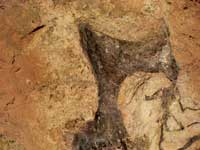 In this era referred to as the late Jurassic, I am incredulous to see dinosaurs roaming freely as they travel over a soggy, featureless landscape dotted with lakes, criss-crossed by sluggish rivers and saturated with swamps and bogs filled with horsetails and succulent plants. Even though I am fascinated with this foreign, long ago capsule of time, I can’t help feeling hopelessly out of place in an environment of unaccustomed humidity and strange habitat. When my time machine zooms me back to the 21st century, I am very happy to return to the world I know! In this era referred to as the late Jurassic, I am incredulous to see dinosaurs roaming freely as they travel over a soggy, featureless landscape dotted with lakes, criss-crossed by sluggish rivers and saturated with swamps and bogs filled with horsetails and succulent plants. Even though I am fascinated with this foreign, long ago capsule of time, I can’t help feeling hopelessly out of place in an environment of unaccustomed humidity and strange habitat. When my time machine zooms me back to the 21st century, I am very happy to return to the world I know!
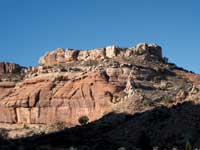 Climate change to a dryer colder environment and the contributing factor of a meteorite impact more than likely caused the extinction of dinosaurs. Unable to adapt, they died out. But the proof that this Jurassic Park really happened between 144 to 155 million years ago, is found in the Morrison Formation - a complex series of clays, shales and sandstones - an excellent setting in the low lying wet areas to record the fossilized remains of numerous dinosaurs. Climate change to a dryer colder environment and the contributing factor of a meteorite impact more than likely caused the extinction of dinosaurs. Unable to adapt, they died out. But the proof that this Jurassic Park really happened between 144 to 155 million years ago, is found in the Morrison Formation - a complex series of clays, shales and sandstones - an excellent setting in the low lying wet areas to record the fossilized remains of numerous dinosaurs.
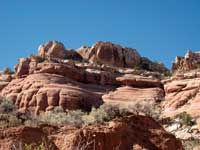
The Mill Canyon Dinosaur Trail, an explanatory self-guided walking tour, is an outdoor natural history museum that has 15 interpretive signs. To get there from Moab, drive north on Highway 191 for about 15 miles and turn left (west) just past highway mile marker 141. Drive across the railroad tracks and after 0.6 mile turn left at the junction. Then drive 0.5 mile to a Y-junction where a sign directs you to turn right for the Dino Trail. Then drive another 0.6 mile through a sandy wash to a parking area and the trailhead. Take note that the road is impassable when wet.
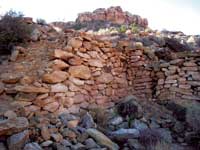
The dinosaurs in Mill Canyon lived along a large, slow moving river, and when they died their bones were probably deposited along a river bend. A covering of sand preserved them, and over eons of time the bones transformed into fossils. In more recent times water erosion dissected this desert area uncovering a lost world in the form of fossils. Allosaurus, a large, bipedal meat-eating dinosaur, was the dominant predator in our area. The vegetarian, plant-eating dinosaurs were: Camarasaurus, who weighed in at 20 tons - the moderately sized, nimble-and-fast Camptosaurs - and the odd looking Stegosaurus, characterized by a double row of large alternately spaced plates that ran down its back ending with large spikes at the tip of its tail.
On a breezy 20 degree morning in late October, as I anxiously wait for the sun to rise, I am glancing over the comments in the trail register. “A fantastic place for six to eight year old kids,” is right on, but I would add that it is also a fantastic place for anyone who is curious about the natural history along this half-mile trail, which has a 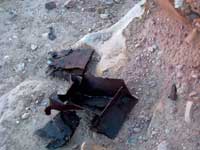 treasure chest of dinosaur bones imbedded in the rock. Since most of these bones are purple, they are easily distinguished from the surrounding bedrock. treasure chest of dinosaur bones imbedded in the rock. Since most of these bones are purple, they are easily distinguished from the surrounding bedrock.
But there is plenty more: petrified wood, a description of the riparian environment in the wash, and river channel cross-bedding, which is a build up of sandstone layers from sediment deposits that have been carried down a course of water. A packrat midden can also be observed; and I have learned that these hoarders collect everything within 200 yards of their den. A midden may preserve its contents for up to 50,000 years, building up many layers, which are studied by scientists looking for time and climate change indicators.
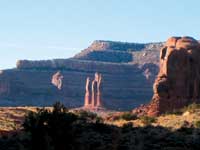 At the end of the trail I cross the wash to access the remnants of the old copper mill for which Mill Canyon was named. The copper ores exposed along the Moab fault were only briefly mined and processed in the late 1800s; limited quantities of ore and fluctuating prices must have made the venture economically unfeasible. Two sides of the mortared stone walls still remain as a testament to a miner’s dreams of striking it rich. At the end of the trail I cross the wash to access the remnants of the old copper mill for which Mill Canyon was named. The copper ores exposed along the Moab fault were only briefly mined and processed in the late 1800s; limited quantities of ore and fluctuating prices must have made the venture economically unfeasible. Two sides of the mortared stone walls still remain as a testament to a miner’s dreams of striking it rich.
Back in the wash I hang a left to continue my walk in a southerly direction, rather than returning to my vehicle, as the loveliness of the canyon beckons me on to indulge in the warm sunshine. With every step I cherish that special flavor of fall - the pale yellow fluttering leaves of willows – the poignant golden colors of the cottonwoods – the bustling breeze rustling through the trees – the pregnant seed harvest of fall.
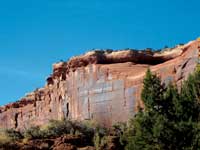 Beyond this short canyon, the spiraling image of Determination Towers, a popular rock-climbing destination, strikes a dramatic pose, and west of them is aptly named Big Mesa. The further I stroll along this old mining road, which is now the well-traveled Monitor and Merrimac bike trail, the wetter it gets, until the water puddles up into pools that sometimes spills over, and then the clear cool waters flow. With so much moisture I find myself traipsing through a bumper crop of taller-than-me rabbitbrush and sagebrush. Beyond this short canyon, the spiraling image of Determination Towers, a popular rock-climbing destination, strikes a dramatic pose, and west of them is aptly named Big Mesa. The further I stroll along this old mining road, which is now the well-traveled Monitor and Merrimac bike trail, the wetter it gets, until the water puddles up into pools that sometimes spills over, and then the clear cool waters flow. With so much moisture I find myself traipsing through a bumper crop of taller-than-me rabbitbrush and sagebrush.
Pausing for a break, I study the curvaceous flow of the canyon walls that sometimes erupt into jagged edges, and the bright red rock sandstone that contrasts strongly against the melancholy blue sky. In the moments of golden silence, I tune in to a noisy, hyperactive Bewick’s wren hopping from branch to branch and the murmured twitters of a small gathering of juncos.
Days are short now and I know I should not dally any longer. With the sun hanging low on the horizon I reluctantly retrace my steps as I savor this special day, a unique blend of natural history going back millions of years to the dinosaurs, the mining years of yesterday and the more recent joys of today’s hike through time.
|
Biological Soil Crust (aka)
Cryptos (krip’ tose):
The surface of
Moab’s desert is held
together by a thin skin of living organisms known as cryptobiotic
soil or cryptos. It has a lumpy black appearance, is very
fragile, and takes decades to heal when it has been damaged.
This soil is a critical part of the survival of the desert.
The cryptobiotic organisms help to stabilize the soil, hold
moisture, and provide protection for germination of the seeds
of other plants. Without it the dry areas of the west would
be much different. Although some disturbance is normal and
helps the soil to capture moisture, excessive disturbance
by hooves, bicycle tires and hiking boots has been shown
to destroy the cryptobiotic organisms and their contribution
to the soil. When you walk around Moab avoid crushing the
cryptos. Stay on trails, walk in washes, hop from stone to
stone. Whatever it takes, don’t crunch the cryptos
unless you absolutely have to! |
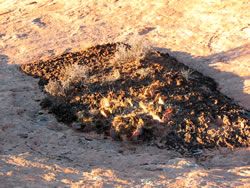
Cryptobiotic soil garden
|
|
|
 In this era referred to as the late Jurassic, I am incredulous to see dinosaurs roaming freely as they travel over a soggy, featureless landscape dotted with lakes, criss-crossed by sluggish rivers and saturated with swamps and bogs filled with horsetails and succulent plants. Even though I am fascinated with this foreign, long ago capsule of time, I can’t help feeling hopelessly out of place in an environment of unaccustomed humidity and strange habitat. When my time machine zooms me back to the 21st century, I am very happy to return to the world I know!
In this era referred to as the late Jurassic, I am incredulous to see dinosaurs roaming freely as they travel over a soggy, featureless landscape dotted with lakes, criss-crossed by sluggish rivers and saturated with swamps and bogs filled with horsetails and succulent plants. Even though I am fascinated with this foreign, long ago capsule of time, I can’t help feeling hopelessly out of place in an environment of unaccustomed humidity and strange habitat. When my time machine zooms me back to the 21st century, I am very happy to return to the world I know!  Climate change to a dryer colder environment and the contributing factor of a meteorite impact more than likely caused the extinction of dinosaurs. Unable to adapt, they died out. But the proof that this Jurassic Park really happened between 144 to 155 million years ago, is found in the Morrison Formation - a complex series of clays, shales and sandstones - an excellent setting in the low lying wet areas to record the fossilized remains of numerous dinosaurs.
Climate change to a dryer colder environment and the contributing factor of a meteorite impact more than likely caused the extinction of dinosaurs. Unable to adapt, they died out. But the proof that this Jurassic Park really happened between 144 to 155 million years ago, is found in the Morrison Formation - a complex series of clays, shales and sandstones - an excellent setting in the low lying wet areas to record the fossilized remains of numerous dinosaurs. 

 treasure chest of dinosaur bones imbedded in the rock. Since most of these bones are purple, they are easily distinguished from the surrounding bedrock.
treasure chest of dinosaur bones imbedded in the rock. Since most of these bones are purple, they are easily distinguished from the surrounding bedrock.  At the end of the trail I cross the wash to access the remnants of the old copper mill for which Mill Canyon was named. The copper ores exposed along the Moab fault were only briefly mined and processed in the late 1800s; limited quantities of ore and fluctuating prices must have made the venture economically unfeasible. Two sides of the mortared stone walls still remain as a testament to a miner’s dreams of striking it rich.
At the end of the trail I cross the wash to access the remnants of the old copper mill for which Mill Canyon was named. The copper ores exposed along the Moab fault were only briefly mined and processed in the late 1800s; limited quantities of ore and fluctuating prices must have made the venture economically unfeasible. Two sides of the mortared stone walls still remain as a testament to a miner’s dreams of striking it rich. Beyond this short canyon, the spiraling image of Determination Towers, a popular rock-climbing destination, strikes a dramatic pose, and west of them is aptly named Big Mesa. The further I stroll along this old mining road, which is now the well-traveled Monitor and Merrimac bike trail, the wetter it gets, until the water puddles up into pools that sometimes spills over, and then the clear cool waters flow. With so much moisture I find myself traipsing through a bumper crop of taller-than-me rabbitbrush and sagebrush.
Beyond this short canyon, the spiraling image of Determination Towers, a popular rock-climbing destination, strikes a dramatic pose, and west of them is aptly named Big Mesa. The further I stroll along this old mining road, which is now the well-traveled Monitor and Merrimac bike trail, the wetter it gets, until the water puddles up into pools that sometimes spills over, and then the clear cool waters flow. With so much moisture I find myself traipsing through a bumper crop of taller-than-me rabbitbrush and sagebrush. 